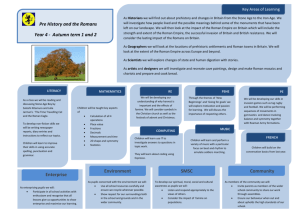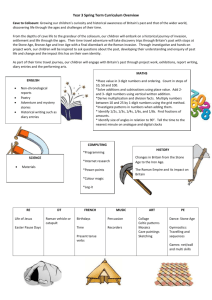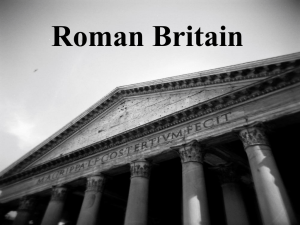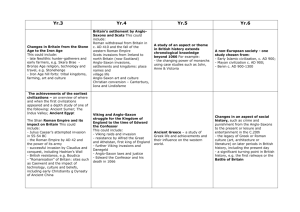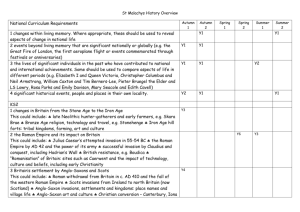University of Kent at Canterbury
advertisement
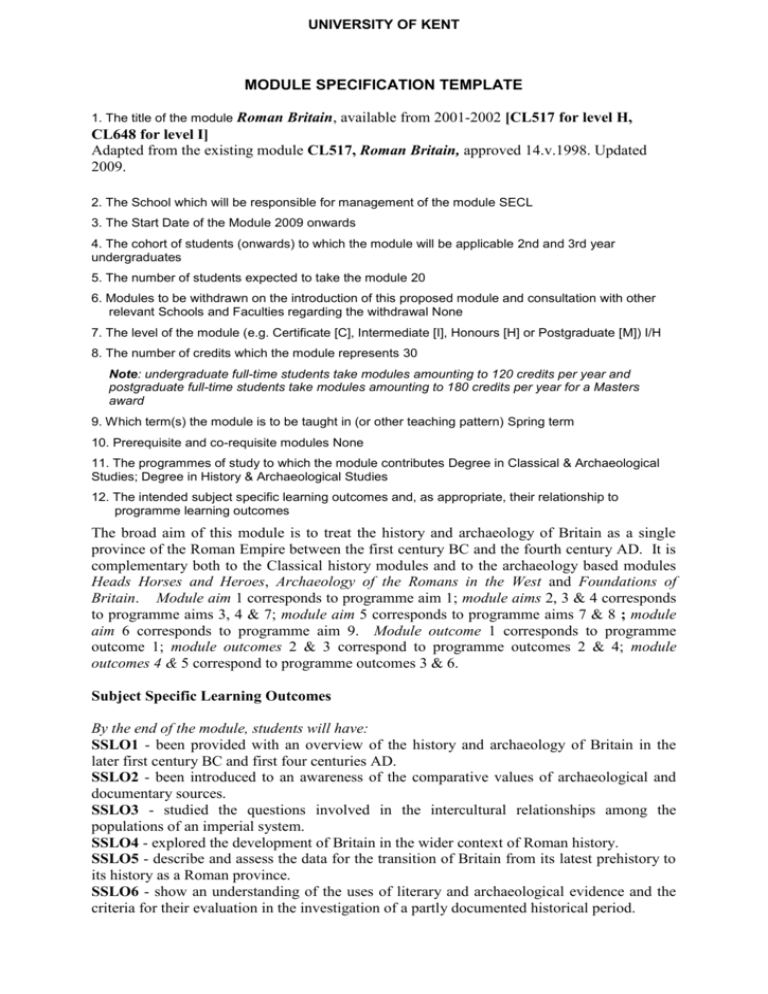
UNIVERSITY OF KENT MODULE SPECIFICATION TEMPLATE 1. The title of the module Roman Britain, available from 2001-2002 [CL517 for level H, CL648 for level I] Adapted from the existing module CL517, Roman Britain, approved 14.v.1998. Updated 2009. 2. The School which will be responsible for management of the module SECL 3. The Start Date of the Module 2009 onwards 4. The cohort of students (onwards) to which the module will be applicable 2nd and 3rd year undergraduates 5. The number of students expected to take the module 20 6. Modules to be withdrawn on the introduction of this proposed module and consultation with other relevant Schools and Faculties regarding the withdrawal None 7. The level of the module (e.g. Certificate [C], Intermediate [I], Honours [H] or Postgraduate [M]) I/H 8. The number of credits which the module represents 30 Note: undergraduate full-time students take modules amounting to 120 credits per year and postgraduate full-time students take modules amounting to 180 credits per year for a Masters award 9. Which term(s) the module is to be taught in (or other teaching pattern) Spring term 10. Prerequisite and co-requisite modules None 11. The programmes of study to which the module contributes Degree in Classical & Archaeological Studies; Degree in History & Archaeological Studies 12. The intended subject specific learning outcomes and, as appropriate, their relationship to programme learning outcomes The broad aim of this module is to treat the history and archaeology of Britain as a single province of the Roman Empire between the first century BC and the fourth century AD. It is complementary both to the Classical history modules and to the archaeology based modules Heads Horses and Heroes, Archaeology of the Romans in the West and Foundations of Britain. Module aim 1 corresponds to programme aim 1; module aims 2, 3 & 4 corresponds to programme aims 3, 4 & 7; module aim 5 corresponds to programme aims 7 & 8 ; module aim 6 corresponds to programme aim 9. Module outcome 1 corresponds to programme outcome 1; module outcomes 2 & 3 correspond to programme outcomes 2 & 4; module outcomes 4 & 5 correspond to programme outcomes 3 & 6. Subject Specific Learning Outcomes By the end of the module, students will have: SSLO1 - been provided with an overview of the history and archaeology of Britain in the later first century BC and first four centuries AD. SSLO2 - been introduced to an awareness of the comparative values of archaeological and documentary sources. SSLO3 - studied the questions involved in the intercultural relationships among the populations of an imperial system. SSLO4 - explored the development of Britain in the wider context of Roman history. SSLO5 - describe and assess the data for the transition of Britain from its latest prehistory to its history as a Roman province. SSLO6 - show an understanding of the uses of literary and archaeological evidence and the criteria for their evaluation in the investigation of a partly documented historical period. UNIVERSITY OF KENT SSLO7 - discuss critically the issues involved in such a concept as Romanisation, using the evidence of archaeological and written sources. SSLO8 - assess the history of Britain as a province in the context of Roman history and provincial administration In addition, H level students will approach the material in this module at a higher level and in a more critical fashion than I level students. H level students will be expected to write and discuss whilst paying attention to articles, books and ideas, commensurate with advanced undergraduate study. 13. The intended generic learning outcomes and, as appropriate, their relationship to programme learning outcomes At the end of the course the student will be able to: GLO1 - construct arguments, orally and in writing, which will demonstrate the generic skills of analytical ability, independence of thought and scholarly synthesis and presentation. (Programme outcomes (Programme outcomes B1-6; C1-6; D1) GLO2 - been encouraged in critical evaluation of diverse sources of data and the different viewpoints of their interpretation. (Programme outcomes C1-6) GLO3 - developed the generic skills of documentary and textual analysis, independence of thought, group work and oral and written presentation of arguments. (Programme outcomes B2, B8, D1, D6 ) These outcomes will be interpreted and tested at levels appropriate to I and H level students. 14. A synopsis of the curriculum The module will deal with the history of the province from the time of Caesar’s invasion down to the final Roman withdrawal. Attention will be paid to the military, social, economic and cultural aspects of the Roman conquest. The course is taught by an archaeologist and an historian. 15. Indicative Reading List Frere, SS Britannia, Routledge, 3rd ed., rev. 1987 Ireland, S Roman Britain, A Sourcebook, Croom Helm, 1997 edn Millett, M The Romanization of Britain, CUP, 1990 Salway, P Roman Britain, OUP, 1981 Todd, M Roman Britain, Harvester Press, 1981 Mattingly, D An Imperial Possession: Britain in the Roman Empire 2006 R. Collingwood and J. Myres, Roman Britain and the English Settlements R.M. Ogilvie and I.A. Richmond, Commentary on Tacitus’ Agricola D.J. Breeze and B. Dobson, Hadrian’s Wall G. MacDonald, The Roman Wall in Scotland W. Hanson and G. Maxwell, Rome’s North West Frontier Caesar, Gallic War UNIVERSITY OF KENT Tacitus, Agricola A. Birley, Septimius Severus S. Johnson, The Roman Forts of the Saxon Shore J. Wacher, Roman Britain P.J. Casey (ed.) The End of Roman Britain Simon James, The Celts 16. Learning and Teaching Methods, including the nature and number of contact hours and the total study hours which will be expected of students, and how these relate to achievement of the intended learning outcomes Contact hours: one two-hour seminar per week for ten weeks and one two-hour class or lecture/seminar per week for ten weeks. (In one week a site/museum visit may be substituted). From 2010 onwards there will be 3 contact hours per week. Total study hours = 300. Teaching will combine several methods, corresponding to the subject matter and the different disciplines involved and thus relating to the learning outcomes described above. There will be one two-hour seminar per week, taught by a historian, with a flexible content which will include student presentations and discussion of documents, and one two-hour lecture-seminar slot per week, taught by an archaeologist, which will combine lectures, student presentations and discussion of documents. The seminar element is intended to encourage the acquisition of the skills of critical awareness, confidence and debate through oral presentation and discussion. This will be supplemented by group project work, to develop team skills, and by document classes, to develop the specialised skills of the study and analysis of evidence. The lecture element is intended mainly for the presentation and illustration of the archaeological data, much of which is not easily or widely accessible to students in primary publications. Seminars will be based on individual student presentations of selected topics for general discussion. In one week a supervised site or museum visit may be substituted for the lectureseminar slot. All students will be practised in the skills of critical discussion debate, the analysis of different kinds of source and the presentation of articulated arguments in written form with appropriate scholarly apparatus. 17. Assessment methods and how these relate to testing achievement of the intended learning outcomes Module is examined by 50% coursework (level I students will write one essays of 1,500 to 2,000 words; level H students will have one 3,000-3,500 word essay to write on a more detailed, researched subject.) and 50% examination (3 hour paper which will include a compulsory question containing extracts from written and epigraphic sources for comment). I and H levels will be distinguished in the examination through different questions at each appropriate level. The essays will be moderated across the range of marks. The essays will include reference to documentary sources, in accordance with the mode of teaching. Preparation of the essays and preparation for the examination will give practise in skills (as described in the learning outcomes above) of presenting arguments and of presenting and comparing different kinds of evidence on historical and archaeological topics, and in the assimilation and articulation of ideas and data discussed in oral presentations, and the paper and the essay questions will be designed to test and enhance the acquisition of these skills. UNIVERSITY OF KENT 18. Implications for learning resources, including staff, library, IT and space None 19. A statement confirming that, as far as can be reasonably anticipated, the curriculum, learning and teaching methods and forms of assessment do not present any non-justifiable disadvantage to students with disabilities As far as can be reasonably anticipated, the curriculum, learning and teaching methods and forms of assessment do not present any non-justifiable disadvantage to students with disabilities
